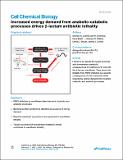Increased energy demand from anabolic-catabolic processes drives β-lactam antibiotic lethality
Author(s)
Lobritz, Michael A; Andrews, Ian W; Braff, Dana; Porter, Caroline BM; Gutierrez, Arnaud; Furuta, Yoshikazu; Cortes, Louis BG; Ferrante, Thomas; Bening, Sarah C; Wong, Felix; Gruber, Charley; Bakerlee, Christopher W; Lambert, Guillaume; Walker, Graham C; Dwyer, Daniel J; Collins, James J; ... Show more Show less
DownloadPublished version (2.557Mb)
Publisher with Creative Commons License
Publisher with Creative Commons License
Creative Commons Attribution
Terms of use
Metadata
Show full item recordAbstract
β-Lactam antibiotics disrupt the assembly of peptidoglycan (PG) within the bacterial cell wall by inhibiting the enzymatic activity of penicillin-binding proteins (PBPs). It was recently shown that β-lactam treatment initializes a futile cycle of PG synthesis and degradation, highlighting major gaps in our understanding of the lethal effects of PBP inhibition by β-lactam antibiotics. Here, we assess the downstream metabolic consequences of treatment of Escherichia coli with the β-lactam mecillinam and show that lethality from PBP2 inhibition is a specific consequence of toxic metabolic shifts induced by energy demand from multiple catabolic and anabolic processes, including accelerated protein synthesis downstream of PG futile cycling. Resource allocation into these processes is coincident with alterations in ATP synthesis and utilization, as well as a broadly dysregulated cellular redox environment. These results indicate that the disruption of normal anabolic-catabolic homeostasis by PBP inhibition is an essential factor for β-lactam antibiotic lethality.
Date issued
2022Department
Massachusetts Institute of Technology. Department of BiologyJournal
Cell Chemical Biology
Publisher
Elsevier BV
Citation
Lobritz, Michael A, Andrews, Ian W, Braff, Dana, Porter, Caroline BM, Gutierrez, Arnaud et al. 2022. "Increased energy demand from anabolic-catabolic processes drives β-lactam antibiotic lethality." Cell Chemical Biology, 29 (2).
Version: Final published version